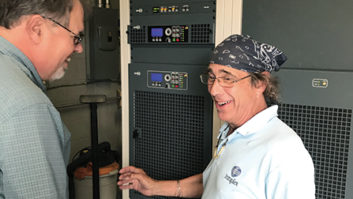Planning a wireless LAN
Aug 1, 2007 12:00 PM, By Kevin McNamara, CNE
Sooner or later you will want to consider deploying a wireless LAN around your facility; or maybe you already have one. In any case, there are some basic guidelines that must be followed to make the system perform to its maximum capacity and keep the network secured.

A wireless LAN antenna can be installed in an equipment room, although ceiling-mount models are available.
I’ll discuss the basic steps to planning a wireless LAN rather than an overview of the emerging standards or the network topologies used. However, be aware of these technologies prior to purchasing any wireless LAN. While equipment conforming to the latest 802.11x standards might provide significant performance improvements and security enhancements, it may not be completely compatible with network interface cards based on earlier standards, resulting in poor performance.
The most common wireless LAN device is the wireless router. These devices have come a long way over the past 10 years. Consumer-grade routers costing $100 now have features found in much more expensive commercial devices, and in most cases also contain an integrated firewall and self-diagnostic features.
When deploying a large-scale wireless network you will likely use dedicated access points (AP), which are basically a means to bridge wireless Ethernet communications to either other wireless 802.11x devices or more commonly, the wired Ethernet network.
Define needs and objectives
The first and most important step is to understand how the wireless LAN will serve the facility. The obvious use would be to replace or supplement an existing wired Ethernet LAN to connect individual users to the network, but consider that the same equipment might also be used to connect two or more networks.
The next step is to define the type of applications to utilize network resources. Broadcast facilities present additional demands on networks when they also carry almost constant streaming digital audio and/or video streams. The design of a wireless LAN must take into consideration the aggregate traffic requirements of streaming data along with the number of users to estimate the peak traffic loads that will occur through a single access point.
You will also want to factor the number of users that will access the network at any given time. Will the users be stationary or will they need to move about the facility? This is important because the performance of an access point can be degraded if too many users are accessing simultaneously. In the case of roaming users, the access points will need to be carefully laid-out in order to maintain seamless coverage and efficient handoffs to adjacent points.
Once these issues have been defined, research and decide on the network architecture and standard to be implemented. While there are newer standards such as 802.11n with more range, faster throughput and enhanced security, consider previous standards that in some cases may be more appropriate due to compatibility with existing hardware and cost.
Finally, consider the budget in the overall scheme. Costs can be significant depending on the objectives defined. In most cases the costs to deploy wireless will exceed that of hardwired LAN. Also consider the cost to support and maintain the system over its life. However, the flexibility fo a wireless LAN might make the investment a worthwhile business case.
Design the LAN
There are third-party vendors who specialize in the deployment of wireless LANs, but it is possible to implement the LAN with little or no support.

A simple wireless router is a basic way to introduce a wireless LAN, but be sure that the proper security is in place.
If the plan is to cover all or a large portion of a facility, then a site survey should be performed. The survey is not unlike any other coverage prediction study. It can be generated through theoretical analysis with specialized computer modeling, the placement of a test transmitter and making signal strength measurements made from deriving the actual strength of a signal at multiple points within the facility, or a combination of both methods. If you attempt this yourself you will need to purchase or lease an 802.11 signal analyzer to measure the field strength.
It helps to have a copy of the facility floor plan, which, if available in a digital format, can be imported into the analysis software to display the signal footprint over the floor plan. Many vendors of 802.11x equipment might provide free analysis for the placement of access points. Also, take into account obvious physical barriers that may limit the propagation of signal to a particular area. These would include studio walls, metal racks and steel support columns.
Plan the configuration of each access point. 802.11x devices are channelized to specific frequency ranges in a group of 12 frequencies. Probably the most important item to be configured will be the selection of channels each access point will operate. Each adjacent access point should be set to a different frequency. The specific frequency generally doesn’t matter provided it is not receiving interference from another access point on the network. In some cases interference may come from another 802.11x device nearby, cordless telephones or even microwave ovens.
Physically locating the access points may also present a challenge. In order to achieve maximum performance, the antennas should be placed below ceiling level. There is a wide selection available to suit most architectural requirements, such as low-profile ceiling mounted units or antennas that can be mounted to a wall or column.
The next problem is to make certain there is ac power available to the access point. Since many times the actual radio portion of the access point is located above the ceiling, an ac outlet will need to be added. Consider using access points powered through the Ethernet cable, which are called Poser over Ethernet (PoE). This eliminates the need for ac power. In most cases you still will need to provide Ethernet cables to the access points anyway.
Test the system thoroughly
Once the system is in place and operational, do not assume all the theoretical predictions are correct. Perform a final site survey to ensure the coverage is uniform, works properly between adjacent access points and provides the specified level of throughput for which the system was originally designed.
Handheld analyzers are relatively inexpensive, starting at under $1,000, and can store data that can be downloaded to a PC for more complex analysis.
The success or failure of a wireless network deployment is ultimately determined by user experience. Proper planning and implementation will ensure users have a reliable system that provides good performance and requires minimal operational support over its life span.
McNamara is president of Applied Wireless, Cape Coral, FL.










